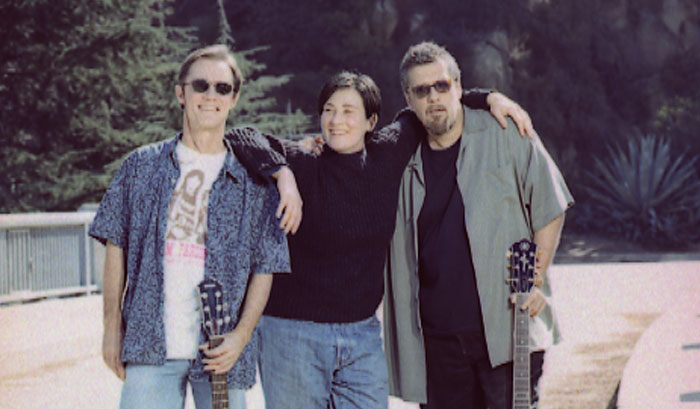


Singer k.d. lang is admired both for her traditional pop and country skills and her restless desire to expand on those traditions. No surprise, then, that her current guitarists, Greg Leisz and Greg Arreguin, are possessed by the same retro-goes-radical spirit.
Leisz has played on most k.d. lang albums from 1989's Absolute Torch and Twang through last year's Invincible Summer. He is also one of L.A.'s busiest session players, with credits that include Joni Mitchell, Fiona Apple, the Wallflowers, Matthew Sweet, Beck, Melissa Etheridge, Shawn Colvin, Joe Cocker, Dave Alvin, Paula Cole, Bill Frisell, and many others. While he is best known for his adventurous lap- and pedal-steel playing (he has, according to k.d. lang, "single-handedly liberated pedal steel from the bondage of country"). Also, he is equally skilled at acoustic and electric guitar, mandolin and Dobro. "Last year when I toured with Emmylou Harris and Linda Ronstadt," he says, "I think I played ten different instruments onstage."
Meanwhile, Greg Arreguin is that rarest of guitarists, an avant-gardist with killer pop instincts. "Maybe it's the Beatles influence," he shrugs. "I've worshipped at their altar since I was a kid." Arreguin has worked with straight-ahead pop acts like Seal, Chris Isaak, Tracy Bonham, as well as with sonic innovators such as Brian Eno and Jon Hassell.
Onstage with k.d. lang, the two Gregs have settled into a standard division of labor. "I play most of the hooks and signature melody lines," says Arreguin, "and he does everything else, from straight rhythm guitar to the sort of improvisation Larry Carlton used to do with Joni Mitchell." Leisz says he relishes the opportunity to play rhythm: "Doing straightforward, in-the-track rhythm stuff is fascinating. It's much harder than playing lines and leads."
Since Leisz and Arreguin must conjure the tones of a dozen years of k.d. lang albums, the stage is crowded with guitars, most of them Yamahas. "I've got five of them," says Arreguin. "There's a bitchin' AES1500 archtop, which I like because it has a warm, woody vintage vibe, but without some of the defining idiosyncrasies of an actual vintage guitar. It's great for getting the fat, midrange sounds you hear on late Beatles records. I have two acoustics, an LL500 dreadnought, and a small-bodied LS500 that I use high-strung (with the lower four strings tuned an octave above normal). The PAC303-12II is a nice electric 12-string. But the guitar I play most is an AES800B, a sweet solidbody with a BigsbyTM tremolo. Its DiMarzioTM humbuckers are super-warm, but with the right amp it can have a great sparkly sound. It's fat in the best sort of way, with just the right low-mids."
Leisz is also an AES800 fan. "I have two," he says. "One I keep tuned down to D. The other is a custom-shop model with a longer scale that I tune all the way down to B. The scale isn't as lengthy as that of most other baritone guitars or 6-string basses, so it plays more like a conventional guitar. And now I'm getting a third one with DiMarzio Virtual Vintage P-90s instead of the stock humbuckers. The humbuckers sound great, but the P-90s are a little better for the sort of twangy baritone stuff I'm doing." Leisz also has an AES1500. "It's a warm instrument with a nice acoustic sound and great bottom end," he says.
Arreguin swears the k.d. lang gig is one of the most pleasant he's ever had. "I call it the endorphin band," he says, "because everyone is so cool, and they all play so ridiculously well. And I relate to the way k.d. switches styles often. I have very little patience for the jackboot of the roots music purists. I grew up in omni-cultural America, and unless you were raised without a radio, you probably did too. The way I see it, if you approach music with integrity, intelligence and heart, you don't have to play according to any so-called rules."
























